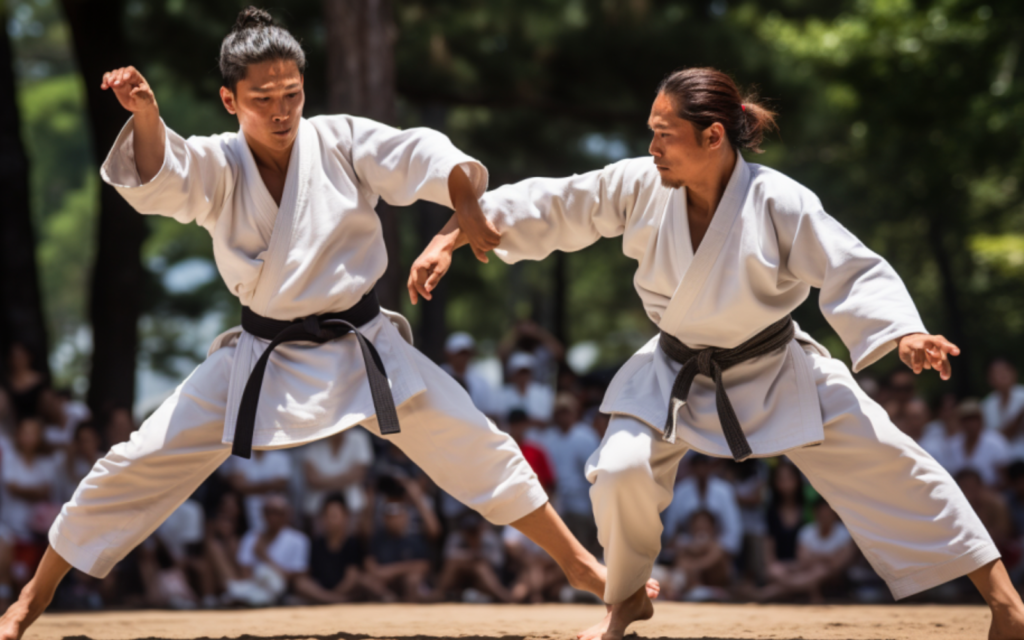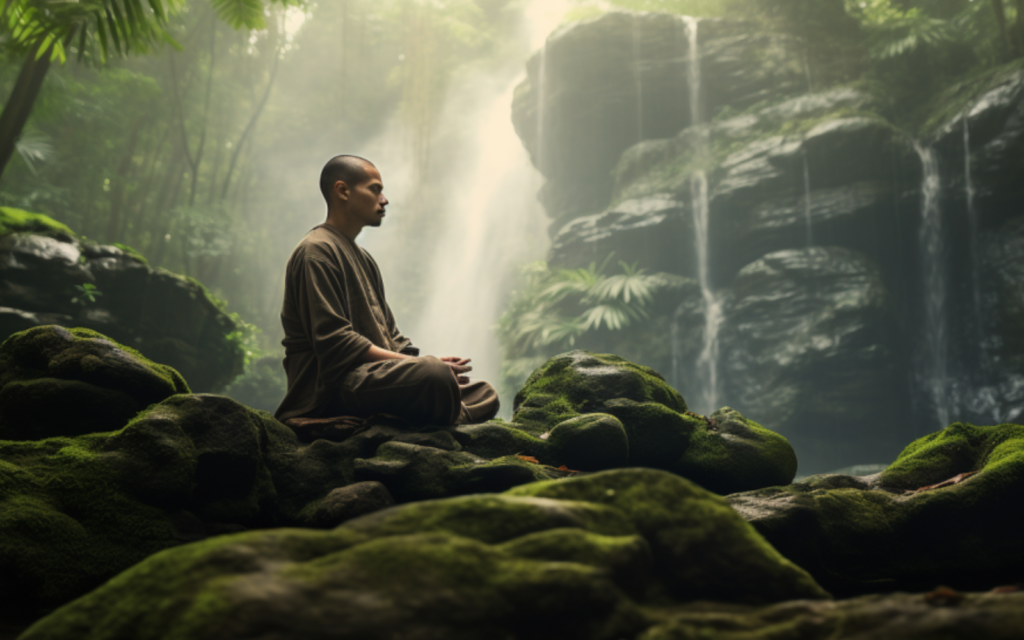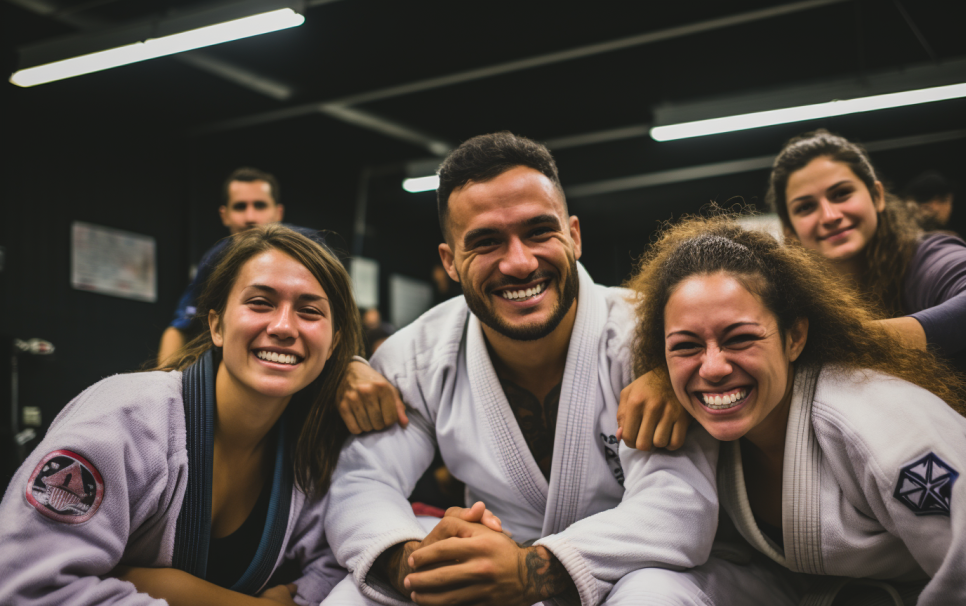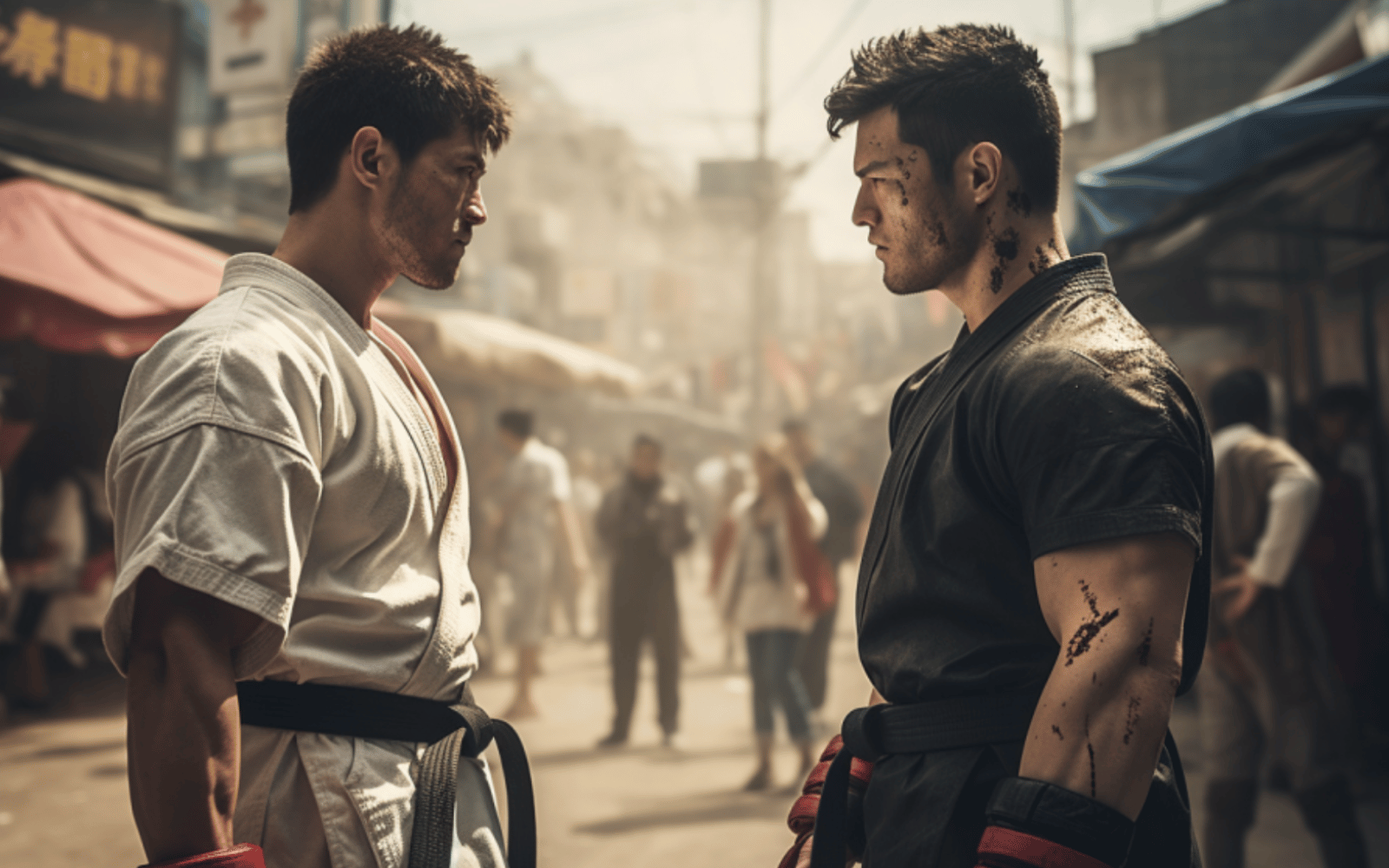Are you wondering which martial art is better for self-defense – Karate vs BJJ?
Look no further!
In this article, we’re looking at both Karate and BJJ, their differing philosophies, and we’re listing out their similarities and differences.
We’ll also examine the effectiveness of Karate’s striking techniques and BJJ’s grappling techniques.
We’ll discuss how both martial arts are applied in self-defense situations.
By the end, you’ll have a better understanding of which martial art suits your self-defense needs.
- Key Takeaways
- Origins of Karate and BJJ
- The Philosophies Behind Karate and BJJ
- Similarities Between Karate and BJJ
- Karate's Striking Techniques and Their Effectiveness
- BJJ's Grappling Techniques and Their Effectiveness
- The Role of Strategy in Karate and BJJ
- The Importance of Footwork in Karate and BJJ
- Karate's Emphasis on Discipline and Respect
- BJJ's Focus on Leverage and Technique
- The Role of Physical Conditioning in Karate and BJJ
- Karate's Use of Kata and Forms in Training
- BJJ's Use of Sparring and Rolling in Training
- Karate's Application in Self-Defense Situations
- BJJ's Application in Self-Defense Situations
- Which Martial Art Is Better for Self-Defense?
- Frequently Asked Questions
- Final Take on Karate vs BJJ
Key Takeaways
- Karate and BJJ are distinct martial arts styles with different focuses on striking and ground fighting techniques.
- Both martial arts prioritize self-defense, technique, and personal growth over brute strength.
- Karate emphasizes quick strikes and mastery of forms, while BJJ focuses on technique and practical application of submissions.
- Regular practice, conditioning, and guidance from experienced instructors are essential for effectiveness in both martial arts.
Origins of Karate and BJJ
If you’re wondering about the differences between Karate and BJJ, let’s start with a quick overview.
Karate and BJJ are two distinct martial arts styles originating in different parts of the world.
Karate, developed in Okinawa, Japan, during the 17th century, heavily influenced by Chinese martial arts, known as “te” (hand).
In 1922, Gichin Funakoshi, a teacher from Okinawa, introduced karate to mainland Japan where it became systematically trained in the country.
After World War II, karate became popular worldwide, especially in the United States. It was officially recognized as a sport by the International Olympic Committee in 2020.

As a martial art, karate focuses on striking techniques such as punches, kicks, and knee strikes and emphasizes speed, power, and precision in executing these techniques.
BJJ, short for Brazilian Jiu Jitsu, originated from the traditional Japanese martial art of Judo in the early 20th century.
The Gracie family are credited with developing the style, after being introduced to Judo by Japanese Judoka Mitsuyo Maeda.
The Gracie family adapted and refined the techniques to focus more on ground fighting and submission holds, giving birth to Brazilian Jiu-Jitsu.
The family is also credited with popularizing Brazilian Jiu-Jitsu internationally through various martial arts competitions, including the Ultimate Fighting Championship (UFC).
BJJ centers around ground fighting and grappling techniques. BJJ practitioners aim to control their opponents through joint locks and chokeholds. And roll with a training partner or grappling dummy to improve leverage and technique rather than relying on strikes.
The Philosophies Behind Karate and BJJ
Both Karate and BJJ share the same core values, with an emphasis on discipline and self-improvement.
Karate places great importance on discipline and self-control. The philosophy of karate centers around the development of mental and physical strength, as well as the cultivation of respect and humility.
Similarly, BJJ’s philosophy revolves around the concept that a smaller and weaker person can successfully defend themselves against a larger opponent by using proper technique and leverage.
BJJ emphasizes the belief that combat is a last resort and techniques should only be used when absolutely necessary.
Both karate and BJJ emphasize self-defense and the importance of technique over brute strength. They provide individuals with the tools to protect themselves in real-life situations.
Additionally, both martial arts offer opportunities for competition, allowing practitioners to test their skills against others.
The philosophy of karate and BJJ encourages continuous self-improvement and personal growth, making them not just effective self-defense systems, but also paths to self-discovery and self-mastery.
Similarities Between Karate and BJJ
As we’ve just shared, both styles share similar philosophies that place emphasis on discipline, self-improvement, and the importance of technique over brute strength.
Both disciplines also encourage practitioners to develop mental and physical discipline, respect, focus, and perseverance.
The training in both karate and BJJ pushes individuals to overcome their limits, improving their physical fitness and mental fortitude.

The similarities don’t end there. Both martial arts place great importance on mastering techniques through rigorous training and repetition.
Both karate and BJJ are also practiced as competitive sports. In karate, practitioners can compete in forms (kata) or sparring (kumite) competitions.
In BJJ, practitioners participate in tournaments where they showcase their grappling skills against opponents of similar skill levels and weight classes.
Competitions allow practitioners to test their skills, gain experience, and further their personal growth.
Both karate and BJJ also have ranking systems, with black belts representing the highest level of achievement.
However, the criteria for earning a black belt differ between the two styles.
Karate often emphasizes mastery of forms and striking techniques, while BJJ focuses on technical knowledge and practical application of submissions over years of training.
Karate’s Striking Techniques and Their Effectiveness
To improve your striking techniques in karate, focus on developing precise and powerful punches, kicks, and knee strikes.
Striking techniques are a fundamental aspect of karate, allowing you to effectively defend yourself in various self-defense situations or martial arts forms.
In karate, the emphasis is on generating maximum power and speed with each strike, making them highly effective in combat scenarios.
Some of the most well-known techniques from karate include:
- Gedan Barai: This technique is also known as the Downward Block and is used to block low attacks to the body.
- Mae Geri: Also known as the Front Kick, this move involves snapping the foot up to strike the opponent.
- Mawashi Geri: This is the Roundhouse Kick and involves swinging the leg around in a circular motion to strike.
- Yoko Geri: Also known as the Side Kick, the practitioner kicks out to the side to strike an opponent.
- Oi Zuki: This is the Lunge Punch, a fundamental karate technique involving a punch delivered while advancing on the opponent.
- Gyaku Zuki: This is the Reverse Punch, a fundamental punch in karate that is executed with the rear hand.
- Kizami Zuki: Known as the Jab, it involves a quick, straight punch with the leading hand.
- Shuto Uke: This is the Knife Hand Block, used to block incoming attacks with the side of the hand.
- Nukite: Also known as the Spear Hand, this technique involves thrusting the fingers towards the opponent’s body, usually eye or throat.
- Empi Uchi: Known as the Elbow Strike, this move involves striking the opponent with the elbow.
- Ushiro Geri: This is the Back Kick, where the practitioner kicks directly behind them.
- Tettsui Uchi: Known as the Hammer Fist Strike, this move involves striking the opponent with the side of a clenched fist, as if swinging a hammer.
- Ashi Barai: This is the Foot Sweep, where the practitioner uses their foot to sweep the opponent’s feet from under them.
- Ippon Ken: Known as the One Knuckle Fist, this technique involves punching with only one knuckle. This can cause intense damage if used properly.
It is important to note that the effectiveness of karate’s striking techniques greatly depends on proper training, timing, and accuracy.
Regular practice and conditioning are essential to develop the strength and speed necessary for powerful strikes.
BJJ’s Grappling Techniques and Their Effectiveness
In BJJ, the focus is on using leverage and technique rather than brute force, making it an effective martial art for ground fighting.
Unlike karate, which primarily emphasizes striking techniques, BJJ emphasizes the importance of grappling and submissions.
Grappling techniques in BJJ are highly effective in self-defense situations, especially in street fights where the fight often ends up on the ground.
By mastering BJJ’s grappling techniques, you can effectively neutralize an opponent’s strikes and gain control over them.
Whether it’s applying joint locks, chokes, or controlling positions like mount or side control, BJJ provides a comprehensive set of techniques to dominate your opponent on the ground.
Some of the most well-known techniques from BJJ include:
- Armbar: A joint-lock technique that involves hyperextension of the elbow joint.
- Rear Naked Choke: A chokehold from behind the opponent, which cuts off blood and oxygen flow to the brain.
- Triangle Choke: A chokehold performed from a position where the practitioner has the opponent’s neck between his/her legs, forming a triangle.
- Kimura: A shoulder lock technique named after the judo champion Masahiko Kimura.
- Guillotine Choke: A chokehold performed from the front of the opponent, typically when the opponent is on their knees.
- Omoplata: A shoulder lock that involves trapping the opponent’s arm and rotating the shoulder joint.
- Kneebar: A leglock that extends the knee joint, similar to the armbar.
- Ankle Lock: A leglock that focuses on the ankle joint, causing pain and potentially forcing the opponent to submit.
- Butterfly Guard: A type of guard where the practitioner hooks their feet inside the opponent’s thighs, allowing for sweeps and submissions.
- D’Arce Choke: A chokehold that compresses the opponent’s carotid arteries, cutting off blood supply to the brain.
- Peruvian Necktie: A chokehold that uses the practitioner’s legs to trap the opponent’s head and arm.
- Heel Hook: A leglock that targets the ankle or the knee known for its potential to cause severe injury.
The Role of Strategy in Karate and BJJ
Understanding the role of strategy is essential in both karate and BJJ, as it allows you to anticipate and counter your opponent’s movements effectively.
In karate, strategy plays a crucial role in determining the outcome of a fight. It involves analyzing your opponent’s strengths and weaknesses and anticipating their attacks to exploit them.
Karate practitioners employ various strategies, such as using distance and timing to their advantage, to gain the upper hand. By understanding the strategic aspects of karate, you can maximize your chances of success in combat.

Similarly, strategy is fundamental in BJJ, especially in ground fighting. Unlike karate, BJJ focuses primarily on grappling and submission techniques.
In this context, strategy becomes even more important as it allows you to control the pace and flow of the fight.
By strategically positioning yourself and anticipating your opponent’s moves, you can effectively neutralize their attacks and find opportunities to execute techniques.
In both karate and BJJ, strategy is about individual techniques and the overall game plan.
It involves adapting to the situation, making quick decisions, and exploiting your opponent’s weaknesses. And honing this strategic mindset can help you become a more formidable opponent in karate or BJJ.
The Importance of Footwork in Karate and BJJ
The importance of footwork is often overlooked in both karate and BJJ, but it is a crucial aspect of both martial arts.
Footwork plays a significant role in determining a fighter’s success in any combat situation.
In karate, footwork enables practitioners to move quickly and effectively, generating power and maintaining balance while executing strikes and blocks.
Maintaining proper distance and positioning is essential to execute techniques with precision.
Similarly, in BJJ, footwork is vital, especially during ground fighting. It allows practitioners to maintain a strong base and control their opponent’s movements.
Proper footwork in BJJ helps execute takedowns, evading, transitions, and submissions. It also helps in preventing opponents from escaping or countering techniques.
In both karate and BJJ, footwork is a fundamental part of the fighting style and is crucial for self-defense.
It enables fighters to evade attacks, maintain a defensive stance, and counter effectively. Footwork allows for fluid movement and quick reaction time, providing an advantage over opponents.
To improve footwork in both karate and BJJ, practitioners should focus on drills and exercises that enhance agility, balance, and coordination.
This includes practicing footwork patterns, shadowboxing, and sparring.
And by emphasizing the importance of footwork and dedicating time to its development, fighters can enhance their overall performance in both martial arts.
Karate’s Emphasis on Discipline and Respect
Practitioners of karate emphasize discipline and respect as essential elements of their training.
When you step into a karate dojo, you enter a world where discipline is paramount.
From the moment you bow upon entering the training area, you are reminded to respect your instructors, fellow students, and the art itself.
Karate is not just about physical techniques; it is a way of life that instills discipline in every aspect of your being.
Through rigorous training and adherence to the principles of karate, you learn to control your body and mind. And developing this self-discipline extends beyond the dojo walls.
Mark Twain
Respect is also deeply ingrained in the fabric of karate. You learn to respect your opponents, acknowledging their skills and abilities.
You bow to them before and after sparring, showing gratitude for the opportunity to practice and grow.
Respect for your instructors is key, as they guide and shape you on your martial arts journey.
In karate, discipline and respect go hand in hand. They form the foundation upon which your training is built.
By embracing these values, you become a skilled martial artist and a better person, instilled with the qualities of discipline and respect that transcend the dojo and permeate every aspect of your life.
BJJ’s Focus on Leverage and Technique
When you practice BJJ, you’ll quickly realize the importance of leverage and technique in every aspect of your training.
Leverage is a fundamental principle in BJJ, allowing you to overcome size and strength disadvantages.
BJJ practitioners are trained to use their opponent’s momentum and body positioning against them, allowing for efficient and effective techniques.
Ground techniques are the cornerstone of BJJ, as the majority of fights end up on the ground.
And BJJ teaches you how to dominate and submit your opponent from various positions on the ground.
You can maximize your effectiveness in these situations by understanding leverage, weight distribution, and body mechanics.
BJJ also places a strong emphasis on the level of technique. Unlike some other martial arts where physical attributes like speed or power may dominate, BJJ rewards skill and knowledge.
Practitioners are encouraged to constantly refine their technique, focusing on precision and efficiency rather than relying solely on physical attributes.
The Role of Physical Conditioning in Karate and BJJ
If you want to excel in Karate and BJJ, you must prioritize your physical conditioning.
You need to have a strong and agile body to execute techniques effectively and efficiently.
In Karate, physical conditioning focuses on developing strength, speed, and flexibility. Karate involves striking techniques such as punches, kicks, and knee strikes.
You need to develop strong core muscles and explosive strength to enhance your striking power.
Incorporating exercises like plyometrics, weightlifting, and cardio will help you improve your overall strength and endurance.
On the other hand, BJJ requires physical conditioning that emphasizes endurance and flexibility. Since BJJ primarily focuses on grappling and ground fighting, you need to have a strong core and upper body.
Strength exercises such as push-ups, pull-ups, and squats are essential for building strength.
Flexibility exercises like yoga and stretching will help you maneuver your body effectively during grappling moves.
In both Karate and BJJ, physical conditioning is essential for self-defense situations. It helps martial artists react quickly and effectively, giving them a competitive edge.
Prioritizing physical conditioning obviously helps improve your performance in both Karate and BJJ, allowing you to excel in the game of mixed martial arts.
Karate’s Use of Kata and Forms in Training
To fully understand the significance of kata and forms in your training, you must recognize their role in developing technique and enhancing focus and discipline.
In karate, kata refers to a set sequence of movements that simulates a fight against imaginary opponents.
These forms are essential to traditional karate training and serve multiple purposes.
First and foremost, kata teaches you the fundamental techniques of karate, such as strikes, kicks, and blocks.
You develop muscle memory and improve your overall technique by practicing these movements repeatedly.
Additionally, kata helps enhance your focus and discipline.
The precise execution of each movement requires concentration and mental clarity. This mental aspect of kata training carries over to other aspects of your martial arts journey.
While kata is a prominent feature in karate, it is not as prevalent in Brazilian Jiu-Jitsu (BJJ). BJJ primarily focuses on ground fighting and grappling techniques.
However, BJJ does have its own equivalent of kata, known as forms or drills.
These forms involve practicing specific techniques repeatedly, such as submissions or escapes, to develop muscle memory and improve proficiency in those techniques.
BJJ’s Use of Sparring and Rolling in Training
In BJJ, sparring and rolling are essential components of your training. They allow you to apply techniques in a live, dynamic setting and improve your grappling skills.

Sparring sessions in BJJ involve engaging in controlled, simulated combat with a training partner. Here, you can practice your moves and apply them under realistic circumstances.
Rolling, on the other hand, involves free-form grappling with a partner. It allows you to experiment with different techniques and test your skills against a resisting opponent.
Sparring and rolling in BJJ provides a unique opportunity to develop your reflexes, timing, and decision-making abilities.
And engaging in live training helps you learn to adapt to different situations and opponents, enhancing your ability to think on your feet and react quickly.
This type of training also helps you develop your physical conditioning and endurance, as grappling can be physically demanding.
Moreover, sparring and rolling allow you to identify the strengths and weaknesses in your techniques.
It lets you refine your moves, understand how they work in real-time, and adjust accordingly.
Through regular rolling, you can gain a deeper understanding of the intricacies of ground fighting and improve your overall grappling skills.
Karate’s Application in Self-Defense Situations
When faced with a self-defense situation, you can utilize the techniques learned in karate to defend yourself against an attacker effectively.
Because Karate emphasizes striking techniques, it is very practical in real-life situations. Karate teaches you how to use strikes to disable an opponent quickly.
Punches, kicks, knee, and elbow strikes are practiced repeatedly in karate training to develop speed, power, and accuracy.
Additionally, karate training includes learning how to defend against different types of attacks, including grabs and chokes.
By honing these skills, you become better equipped to handle a variety of self-defense scenarios.

In self-defense situations, karate’s emphasis on striking techniques can be particularly useful.
By utilizing your training, you can quickly disable an attacker and create an opportunity to escape or move to the next opponent quickly.
But it’s important to remember that self-defense is not just about physical techniques.
Situational awareness, de-escalation techniques, and understanding legal implications are also crucial aspects of self-defense.
BJJ’s Application in Self-Defense Situations
When comparing karate and BJJ’s application in self-defense situations, one of the key differences lies in their form and approach.
In real-life street fighting scenarios, the ability to control and submit an opponent using grappling techniques can be invaluable.
BJJ’s self-defense system is designed to prepare you for real-life encounters where the fight may go to the ground.
It teaches you how to defend yourself from various positions, such as being mounted or taken down. And it gives you the skills to neutralize an attacker and safely escape dangerous situations.
In contrast, karate’s lack of grappling techniques can be a disadvantage in certain self-defense scenarios.
While karate is effective for striking and can help you defend against attackers, it may not be as effective in dealing with larger or stronger opponents with grappling advantages.
Which Martial Art Is Better for Self-Defense?
To determine which martial art is better for self-defense, you should consider the effectiveness and versatility of each style.
As we’ve discussed, Karate focuses on striking techniques, such as punches, kicks, and knee strikes, while BJJ emphasizes ground fighting and submission holds.
Karate is known for its powerful and explosive strikes, making it effective in stand-up fighting situations.
It teaches practitioners to defend against various attacks and develop quick reflexes. However, it may not be as effective in ground-fighting scenarios.
And ground-fighting is where BJJ excels.
BJJ emphasizes leverage, joint locks, and chokeholds to neutralize opponents. It focuses on techniques that allow smaller individuals to overcome larger and stronger opponents.
BJJ works best in scenarios of one-on-one fighting that goes to the ground. If a Bjj practitioner can bring his or her opponent to the ground in a street fight, there’s very little chance his opponent will win.
But Karate has an advantage if it is a standing fight or if the Karate practitioner is facing off against multiple opponents. Why? Because by relying on strikes, a fighter can pivot between opponents. And a strong strike can ensure that the fight doesn’t go to the ground – only your opponent does.
Ultimately, the choice between practicing karate or BJJ for self-defense depends on your personal preferences, goals, and the specific situations you anticipate encountering.
Frequently Asked Questions
Here are some answers to the frequently asked questions concerning karate vs BJJ.
How Does BJJ Prepare Practitioners for Real-Life Self-Defense Scenarios?
Sparring and rolling in BJJ training help prepare you for real-life self-defense. It teaches you to apply techniques under pressure, defend against different attacks, and control opponents.
Who are some famous karate practitioners in the UFC?
Karate has been a pillar of many UFC fighters’ training. Just some of the UFC fighters who have trained in karate include:
- Georges St-Pierre
- Stephen Thompson
- Robbie Lawler
- Sage Northcutt
- Robert Whittaker
- Michael Bisping
- Conor McGregor
- Holly Holm
- Joanna Jedrzejczyk
Who are some famous BJJ practitioners in the UFC?
BJJ’s early dominance in the UFC has ensured that fighters must become versatile in their training and fighting styles. Some of the top BJJ practitioners in the UFC include:
- Royce Gracie
- Demian Maia
- Fabricio Werdum
- BJ Penn
- Nate Diaz
- Charles Oliveira
- Rafael Dos Anjos
- Gilbert Burns
- Sergio Moraes
- Alexandre Ribeiro
- Gunnar Nelson
- Augusto Mendes
But to succeed, everyone in the UFC must be well-versed in BJJ, Sambo, Wrestling, or other grappling arts.
Final Take on Karate vs BJJ
In conclusion, both Karate and BJJ have their own unique strengths and applications in self-defense situations.
Karate’s emphasis on striking techniques can effectively incapacitate an attacker.
BJJ’s focus on grappling and ground fighting can provide a strong advantage in close-quarters combat.
Ultimately, choosing between the two martial arts depends on personal preference, physical abilities, and training goals.
Both Karate and BJJ offer valuable skills and techniques that can benefit self-defense.
